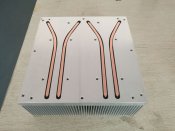热管散热器由密封管、吸液芯和蒸汽通道组成。吸液芯环绕在密封管的管壁上,浸有能挥发的饱和液体。这种液体可以是蒸馏水,也可以是氨、甲醇或丙酮等。充有氨、甲醇、丙酮等液体的热管散热器在低温时仍具有很好的散热能力。
热管散热器运行时,其蒸发段吸收热源(功率半导体器件等) 产生的热量,使其吸液芯管中的液体沸腾化成蒸汽。带有热量的蒸汽就从热管散热器的蒸发段向其冷却段移动,当蒸汽把热量传给冷却段后,蒸汽就冷凝成液体。冷凝的液体便通过管壁上吸液芯的毛细管作用返回到蒸发段,如此重复上述循环过程不断地散热。
 The heat pipe radiator consists of a sealed pipe, a suction core and a steam passage. The suction core surrounds the wall of the sealed tube and is impregnated with a saturated liquid that can volatilize. This liquid can be distilled water, or it can be ammonia, methanol or acetone. The heat pipe radiator filled with ammonia, methanol, acetone and other liquids still has a good heat dissipation ability at low temperatures.
When the heat pipe radiator is running, the evaporation section absorbs the heat generated by the heat source(power semiconductor device, etc.) and boils the liquid in the suction core tube into steam. The steam with heat moves from the evaporation section of the heat pipe radiator to its cooling section. When the steam passes the heat to the cooling section, the steam condenses into a liquid. The condensed liquid returns to the evaporation section through the capillary action of the suction core on the wall of the tube, so that the above cycle process is continuously dissipated.
The heat pipe radiator consists of a sealed pipe, a suction core and a steam passage. The suction core surrounds the wall of the sealed tube and is impregnated with a saturated liquid that can volatilize. This liquid can be distilled water, or it can be ammonia, methanol or acetone. The heat pipe radiator filled with ammonia, methanol, acetone and other liquids still has a good heat dissipation ability at low temperatures.
When the heat pipe radiator is running, the evaporation section absorbs the heat generated by the heat source(power semiconductor device, etc.) and boils the liquid in the suction core tube into steam. The steam with heat moves from the evaporation section of the heat pipe radiator to its cooling section. When the steam passes the heat to the cooling section, the steam condenses into a liquid. The condensed liquid returns to the evaporation section through the capillary action of the suction core on the wall of the tube, so that the above cycle process is continuously dissipated.

